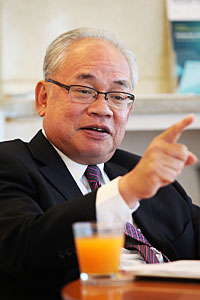Asean, comprising open trading nations and net importers of energy, has been severely impacted by the economic disruptions linked to the pandemic and the economic fallout arising from the ongoing geopolitical conflicts, notably, through higher food and energy prices and more restrictive trade flows.
As a result, economic growth in Asean declined in the last two years: to about -3.8% in 2020 and 3.2% in 2021. The outlook for 2022 and the next year is set to improve, boosted by economic reopening. Nonetheless, downside risks to the outlook are many. The key ones are rising global inflation, monetary policy tightening in the US, and possible further fallout from geopolitical conflicts that could lead to recessionary conditions worldwide.
Therefore, in the context of policy, the first and most immediate area of concern is rising inflationary pressure together with the more hawkish stance of US monetary policy to fight inflation that could pose threats to the region's growth and financial stability.
This is because tightened global financial conditions, coupled with a strong US dollar, could lead to higher borrowing costs, capital outflows, and financial market volatility in the region. Specifically, higher US interest rates and volatility spikes could fuel risk aversion, cause higher debt service and refinancing risk, and lead to asset repricing that depresses regional growth.
To this end, the challenge for policy in Asean is how to ensure continued economic recovery while taking control of inflation without jeopardising financial stability.
So far, inflation in the Asean countries has been more modest compared to the rest of the world, averaging about 4.7% up to April this year compared to the emerging market average of about 8% globally.
There is a noted variation of inflation rates amongst Asean countries: from those with inflation below 5% so far in 2022 such as Malaysia, Vietnam, and Indonesia, to those with inflation higher than 5% such as Laos, Singapore, the Philippines, and Thailand.
The variation reflects differences in economic performance as well as how robust the conduct of monetary policy has been in addressing inflation. Reflecting lower inflation rates in the region, monetary policy actions in Asean economies so far are seen as being less aggressive in fighting inflation compared to what other emerging markets have done globally.
Nonetheless, with US interest rates now trending up strongly, such an approach would need to be reviewed and adjusted appropriately as a slower response to address inflation by monetary policy could pose serious threats to the region's financial stability.
First, continued low interest rates could encourage robust domestic demand in the environment of a more restrictive supply response that would further fuel inflation and lead to worsening current account positions.
Second, persistent wide interest rate differentials could set the stage for strong capital outflows, greater financial market volatility, and much weaker currencies, thereby adding more pressure to refinancing risk and domestic inflation.
Third, higher current account deficits and attempts to shore up weakening currencies through market intervention could lead to declines in international reserves.
These pressures are signs of macroeconomic imbalance that, if prolonged, could threaten the region's economic and financial stability. They are developments that need to be closely monitored so that policy can be adjusted in a timely manner to ensure a safe recovery path while maintaining financial stability.
In the medium term, Asean countries will also face a challenge in adapting to the changing global economic environment to ensure sustainable growth. This is to say the global environment that used to benefit Asean economies in the past such as globalisation, low inflation environment, and favourable demographic factors, might not be as supportive as before.
First, globalisation is being importantly undermined by anti-free trade policies and measures linked to anti-competition sentiment and geopolitics. This could severely shrink global trade and split trading nations into blocs or groups, thus limiting trade and investment flows while raising production costs worldwide.
Hence, there is a need for countries to continue to cooperate to promote trade and investment, and a forum like what we have today is timely and important.
Second, partly reflecting this, the global economy is transiting from a low inflation environment that had been the bedrock of global growth for more than 20 years into a new environment of higher inflation. Such a transition will harm global growth and limit collaboration and innovation.
Third is an ageing population whereby many countries in Asia and in Asean, Thailand included, will face the challenge of a declining workforce with important implications for the countries' economic growth, productivity, and social cohesion.
These are important challenges that Asean countries will face going forward.
They call for policies to reform and transform the economies to be ready for the emerging new global environment and changes. Such tasks will be huge, important, and challenging for Asean policymakers.
Dr Bandid Nijathaworn, Chairman, Foundation for Public Policy and Good Governance, Bangkok. The piece is an excerpt from his Keynote Address at the Hainan Free Trade Port and Asean Countries Financial Cooperation Forum on Sept 25, 2022.
